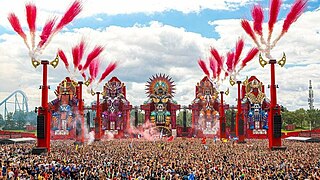
Drum and bass is a genre of electronic dance music characterised by fast breakbeats with heavy bass and sub-bass lines, samples, and synthesizers. The genre grew out of the UK's jungle scene in the 1990s.
House is a genre of electronic dance music characterized by a repetitive four-on-the-floor beat and a typical tempo of 115–130 beats per minute. It was created by DJs and music producers from Chicago's Black gay underground club culture and evolved slowly in the early/mid 1980s as DJs began altering disco songs to give them a more mechanical beat. By early 1988, House became mainstream and supplanted the typical 80s music beat.
Trance is a genre of electronic dance music that emerged from EBM in Frankfurt, Germany, in the late 1980s and early 1990s, and quickly spread throughout Europe.
Electronica is both a broad group of electronic-based music styles intended for listening rather than strictly for dancing and a music scene that came to prominence in the early 1990s in the United Kingdom. In the United States, the term is mostly used to refer to electronic music generally.
Microhouse, buftech or sometimes just minimal, is a subgenre of house music strongly influenced by minimalism and 1990s techno.
Tech house is a subgenre of house music that combines stylistic features of techno with house. The term tech house developed as a shorthand record store name for a category of electronic dance music that combined musical aspects of techno, such as "rugged basslines" and "steely beats", with the harmonies and grooves of progressive house. The music originally had a clean and minimal production style that was associated with techno from Detroit and the UK.
Downtempo is a broad label for electronic music that features an atmospheric sound and slower beats than would typically be found in dance music. Closely related to ambient music but with greater emphasis on rhythm, the style may be played in relaxation clubs or as "warm-up or cool-down" music during a DJ set. Examples of downtempo subgenres include trip hop, ambient house, chillwave, psybient and lofi hip hop.
Electro is a genre of electronic dance music directly influenced by the use of the Roland TR-808 drum machines, with an immediate origin in early hip hop and funk genres. Records in the genre typically feature heavy electronic sounds, usually without vocals; if vocals are present, they are delivered in a deadpan manner, often through electronic distortion such as vocoding and talkboxing. It palpably deviates from its predecessor boogie by being less vocal-oriented and more focused on electronic beats produced by drum machines.

Hardstyle is an electronic dance genre that emerged in the late 1990s, with origins in the Netherlands, Belgium and Italy. Hardstyle mixes influences from techno, new beat and hardcore.
Minimal techno is a subgenre of techno music. It is characterized by a stripped-down aesthetic that exploits the use of repetition and understated development. Minimal techno is thought to have been originally developed in the early 1990s by Detroit-based producers Robert Hood and Daniel Bell.
Hard trance is a subgenre of trance music that originated in Belgium, Germany and the Netherlands in the early 1990s as the Breakbeat hardcore production community began to diversify into new and different styles of electronic music, all influenced by Hard house, New beat, Happy hardcore and Jungle music. The popularity of hard trance peaked during the late 1990s and has since then faded in scope of newer forms of trance.

Dance music is music composed specifically to facilitate or accompany dancing. It can be either a whole piece or part of a larger musical arrangement. In terms of performance, the major categories are live dance music and recorded dance music. While there exist attestations of the combination of dance and music in ancient history, the earliest Western dance music that we can still reproduce with a degree of certainty are old-fashioned dances. In the Baroque period, the major dance styles were noble court dances. In the classical music era, the minuet was frequently used as a third movement, although in this context it would not accompany any dancing. The waltz also arose later in the classical era. Both remained part of the romantic music period, which also saw the rise of various other nationalistic dance forms like the barcarolle, mazurka, ecossaise, ballade and polonaise.
Drum and bass is an electronic music genre that originated in the UK rave scene having developed from breakbeat hardcore. The genre would go on to become one of the most popular genres of electronic dance music, becoming international and spawning multiple different derivatives and subgenres.
Dub techno is a subgenre of electronic music that originated in the early 1990s, blending the repetitive, minimal structures of techno with the echo-laden, spacey production techniques of dub music. It is notable for its deep, atmospheric soundscapes, layers of elaborate basslines, slowly developing musical phrases featuring heavy delay and reverb effects. Vocals are either absent, or inspired by dub and ambient music.
Electro house is a genre of electronic dance music and a subgenre of house music characterized by heavy bass and a tempo around 125–135 beats per minute. The term has been used to describe the music of many DJ Mag Top 100 DJs, including Benny Benassi, Skrillex, Steve Aoki, and Deadmau5.
Big room house or simply big room is a fusion subgenre of house music that gained popularity in the early 2010s. Although the term "big room" started appearing in news articles circa 2007, the current state of this subgenre emerged around 2010—12 and was popularized by songs such as "Epic" and "Cannonball". From 2013 on, artists like Martin Garrix, KSHMR, Dimitri Vegas & Like Mike, Hardwell, Nicky Romero, Afrojack, and R3HAB began experimenting with this sound in their compositions.


